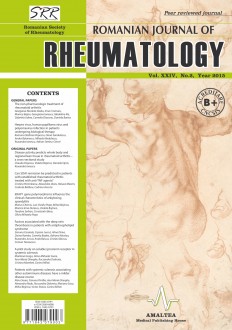SELECT ISSUE

Indexed

| |

|
|
|
| |
|
|
|

|
|
|
|
|
|
| |
|
|
HIGHLIGHTS
National Awards “Science and Research”
NEW! RJR has announced the annually National Award for "Science and Research" for the best scientific articles published throughout the year in the official journal.
Read the Recommendations for the Conduct, Reporting, Editing, and Publication of Scholarly work in Medical Journals.
The published medical research literature is a global public good. Medical journal editors have a social responsibility to promote global health by publishing, whenever possible, research that furthers health worldwide.
CAN SDAI REMISSION BE PREDICTED IN PATIENTS WITH ESTABLISHED RHEUMATOID ARTHRITIS TREATED WITH ANTI-TNF AGENTS?
Cristina Pomirleanu, Alexandra Jitaru, Raluca Maxim, Codruta Belibou and Codrina Ancuta
ABSTRACT
Objective. To identify predictors for Simplified Disease Activity Index (SDAI) remission in established rheumatoid arthritis (RA) and to develop a predictive score for remission.
Methods. Prospective 12-month observational study in ninety active RA receiving their first TNF-α inhibitor. Standard assessments consisted of disease activity scores (DAS28-ESR, SDAI) and immune parameters (total rheumatoid factor, RF; IGA-RF; anti-cyclic citrullinated peptide antibodies, ACPA). The primary outcome measure was SDAI remission (≤ 3.3) at 12 months. Univariate and multivariate logistic regression models were used to estimate association between baseline variables and SDAI remission.
Results. 39.7% RA achieved remission, while 56.8% low disease activity. Significant association between SDAI remission and RA-onset before 50 (p = 0.000), history <5 years (p = 0.000), stage (p = 0.000), class I and II Steinbroker functional status (p = 0.022), HAQ-DI≤2 (p = 0.034), CRP ≤ 20mg/l (p = 0.041), IgA-RF ≤ 20 IU/ml (p = 0.002), ACPA ≤ 40 IU/ml (p = 0.047), concomitant DMARDs (p = 0.003) were identified. Four parameters independently predicted 12-month remission (age at onset under 50, RA duration <5 years, ACPA≤40 IU/ml, IgA-RF ≤ 20 IU/ml) as demonstrated by multivariate logistic regression (p<0.05), making correct prediction in 84.4% patients. Furthermore, the remission score correctly classified 90.6% RA, while the transformed simplified version up to 89.4% cases. Gender, clinical parameters and ESR were not predictors for treatment response (p > 0.05).
Conclusion. SDAI remission can be predicted in established RA using a score based on age at onset, disease duration, titers of ACPA and RF isotype A. Such a simplified score may help clinicians to manage remission in RA patients according to the current treatment guidelines.
Keywords: anti-TNF agents, established rheumatoid arthritis, predictors, remission, SDAI
